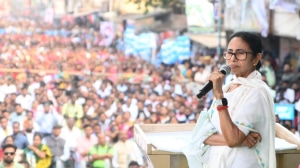Stay updated with the latest - Click here to follow us on Instagram
Hanged for mutiny, forgotten for the lack of gratitude: 12 soldiers of British Indian Army
However, very little is known about them even in Tarn Taran. “Governments still see them as terrorists. They don’t want to tell their stories,” says Surjit Singh, grandson of Wadhawa Singh of Rurewala village, who was among the 12 hanged.
 A gurdwara and memorial have been constructed in their memory at the village. This memorial is also shared by two martyrs from the 1971 war. (Express)
A gurdwara and memorial have been constructed in their memory at the village. This memorial is also shared by two martyrs from the 1971 war. (Express)On September 3, 1915, 12 soldiers of British India Army were hanged in the Ambala jail for their involvement in the 1915 Gadar (mutiny). A total of 18 soldiers were sentenced together, but death penalty of six of them was later converted into life term. All of them belonged to seven villages that now fall in a 20-km area of Tarn Taran district. They all were deployed in the 23rd cavalry in Mian Meer cantt of Lahore. All horsemen, they lived together, fought together and died together. Now their remains rest together in a corner of Ambala jail.
However, very little is known about them even in Tarn Taran. “Governments still see them as terrorists. They don’t want to tell their stories,” says Surjit Singh, grandson of Wadhawa Singh of Rurewala village, who was among the 12 hanged.
Historian Malwinderjit Singh Wraich terms their hanging “the biggest mass hanging of freedom fighters in the 20th century British India”. He has dug out documents of their court martial that suggest that Lance-Daffadar Lachman Singh was the first to have a burning sense of patriotism. He came in contact with Bhasaur Singh Sabha, a body of reformist Sikhs. Later, he established contact with the Gadar party.
The statement of Mool Singh, a Sikh priest deployed in their regiment, during the court marshal reads, “The unsuccessful voyage of Gurdit Singh’s ship Kamagatamaru to Canada and the Budge Budge Ghat (Kolkata) affair was the main cause which operated to excite the minds of the Sikhs in general against the British Government. The men of the regiment, who went on leave, to their villages, returned affected, and a similar effect was caused through letters received by these men from their relations and friends abroad. Besides these influences, the news of the movement among returned emigrants and their practical work reached the men freely, inflaming their minds.”
Lachman Singh and his companions, the documents note, were ready for the Gadar revolt on November 17, 1914. But the date was postponed. They were again ready to revolt on the midnight of November 27, 1914. This time, Moola Singh advised them against it and asked them to first wait for solid action from the Gadar Party. Later, however, the soldiers regretted having listened to him.
All the soldiers used to hold their meetings with the Gadar party members at Gurdwara Jhar Sahib, around 20 km from Lahore. They learnt to make bombs after some failed experiments. However, their success in making bombs led to their arrest as one such bomb exploded at Harpalpur on May 13, 1915. A case was registered against them and was concluded in less than a month. A court martial was held at Dagshai in Solan, now in Himachal Pradesh, which pronounced death sentence on all 18 accused, but later death penalty of six of them was converted into life term.
Some families of martyrs took the initiative to remember their sacrifice ahead of 100th anniversary of their hanging that was observed on September 3, 2015. However, official recognition has not come their way — even on the 75th anniversary of Independence when Azadi Ka Amrit Mahotsav is being celebrated.
None of their family members has got any benefits meant for relatives of freedom fighters. In fact, the Punjab government recognised movements, including Gurudwara Reform Movement, Gadar Movement, Kukka Movement and Kamagatamaru Movement, as part of freedom struggle only in 2011.
Four of these Gadarites were from Rurewala village. A gurdwara and memorial have been constructed in their memory at the village. This memorial is also shared by two martyrs from the 1971 war.
A stone memorial has been installed with names of six martyrs at Dhotian village. Government Senior Secondary School
has been named after martyr Inder Singh at Shubazpur village.
There is a road named after Budh Singh from his native village of Dhotian to nearest town Nushehra Panu.
That’s all these martyrs have got in their memory. “All four Gadari martyrs — Bhagat Singh, Mota Singh, Wadhwa Singh and Tara Singh — had dsappeared from the memory of our village. Still some people remembered them and a memorial came up at village gurdwara,” says Master Harjit Singh, who runs a private school at the village.
Harjit Singh explains how memories of these martyrs vanished from the minds of the locals. “The involvement of martyrs in Gadar movement badly affected their relatives. Some of the families shifted from their villages due to British suppression. Others just stopped talking about it due to the fear of the British. Then, after Independence, Gadarites did not get their due. Families of the Gadarites did not enjoy the status given to the families of freedom fighters.”







